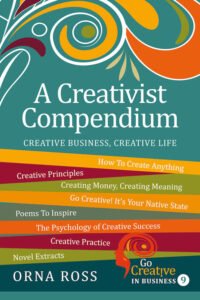Creativism is: the conscious application of creative principles to everything in life
A Creativist is: a person who applies creative principles to the art of living e.g. home, relationships, money, work.
Creativists adopt conscious creation as a way of life. We recognize that the creative process is not confined to the fields of art and literature, but can be consciously applied to anything we want to make.
Just like the productive writer or artist, the creativist knows to integrate the conscious and subconscious, and open to creative flow.
Creativism
I started to use the terms “creativism” and “creativist” when I began this blog back in 2008. I needed to distinguish the everyday application of the creative process from “creativity”, which most people associate with music, art and creative writing.
Creativism seemed the right word.
In my thirty plus years as a writer, I’ve had the privilege of working with some of the world’s most imaginative and innovative people: activists, actors, artists, authors, designers, filmmakers, illustrators, performers, photographers, and publishing professionals. I also spent some years in a university, teaching creative and imaginative studies from an academic perspective. Across that time, I’ve found that few people—even those who are highly creative themselves—can articulate what that word means.
If you ask an artist for a definition of creativity, you’ll get a different answer, using different language, describing different aspects of life, than if you ask an inventor, a coder, or an entrepreneur. The dictionary doesn’t help: there are many definitions of creativity, some plain wrong and most incomplete.
The only all-encompassing definition is the simplest and most obvious—Creativity is self-expression—except that hardly helps at all. We each express ourselves so differently and none of us is a singular, coherent self anyway. As the American bard, Walt Whitman, famously put it in “Song of Myself”: “Do I contradict myself? Very well then, I contradict myself; (I am large, I contain multitudes.)”
Going creative is not about growing your hair or your beard, living in a commune or a warehouse, getting high or getting laid, sleeping around or sleeping in a squat, wearing hipster glasses or hippie clothes, indulging in outrageous tantrums, drunken debauchery or high drama. It’s directing your creative energy toward something you truly desire. Stretching yourself, taking a risk, and putting yourself out there to make something you need or want to make.
We completely misunderstand what it is to be creative if we think it’s restricted to particular tasks—writing but not marketing, for example. Or if we see creativity as a talent or skill that some people (writers) have, but others (business people), don’t. Writing can be cranked out in a rote, uncreative, commercial way while the tasks of running an author business offer countless opportunities to be innovative, imaginative and expressive. An entrepreneur can display dazzling creativity, while a writer can be a hack, routinely going through the motions.
In 2013, the Red Bull Cracking Creativity Project1, a collaboration between the energy drinks company, a group of TED Fellows and a number of scientists at the MIT Media Lab, ran the largest review of creativity research yet done. The project examined more than 30,000 research papers and interviews with hundreds of subjects—poets, rock stars, circus performers, all kinds of people—to see if the question “what is creativity?” could be answered definitively.
This review arrived at an overarching conclusion confirmed by other studies before and since, and by my own experience and observation of author-publishers. We have little success in training people to be more creative because we treat it as if it were a skill producing an product, when really it’s a state engaged in a process.
That’s the understanding of creativity that underwrites this book.
What does a Creativist Do?
What is it that artists, writers and musicians do? They transform materials — paint, music, stone, film, words — into something new. Something that didn’t exist before, that expresses something deep and true and particular to them, that connects them to others.
A creativist does the same, takes this attitude, moment by moment, into daily life. They see career, marriage, family, friendships, home, money, clothes, all of life as an opportunity for self-expression and creative connection.
A Creativist World
Just as good art transforms materials into the beauty of truth, the delight of wisdom, creativists aim to create truth, beauty, wisdom and delight too.
Creativists foster economies and societies that recognize the individual and the collective; the male and the female, the material and the intangible. We align with social structures that foster growth and empowerment for ourselves and others, within a context of creative containment and balance.
Crucially, creativists acknowledge that our first duty is to create these conditions within. Only then can we create them in the world.
Creativism, as a state of mind and a way of life, can lead us beyond consumerism.
